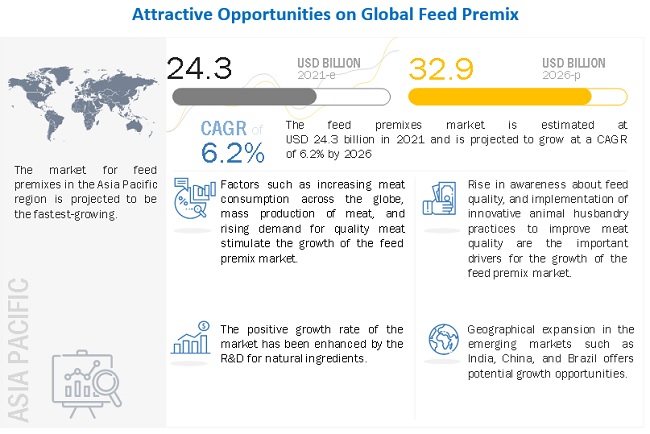The global Feed Premix Market size is estimated to be valued at USD 24.3 billion in 2021 and is projected to reach a value of USD 32.9 billion by 2026, growing at a CAGR of 6.2% during the forecast period. The growth of this market is attributed to the increasing demand for meat and meat products across the globe.

Driver: Increase in the demand and consumption of livestock based products
An increase in the demand and consumption of livestock-based products such as dairy & dairy-based products, meat, and eggs is expected to drive the usage of feed additives for the growth and development of farm animals. According to FAO data, it has been stated that global meat production is projected to be 16% higher by 2025. Poultry meat is the primary driver for the growth of the overall meat production, owing to its high demand, low production cost, and lower product prices, both in developed and developing countries. According to FAO statistics, it has been stated that the production of poultry meat reached 120.5 million tons in 2017, whereas swine meat recorded 118.7 million tons, bovine meat recorded 70.8 million tons, and ovine meat recorded 14.9 million tons. Owing to the increasing awareness about the role and dynamics of food nutrients, especially protein, on overall physical and mental growth and development, there is a growing inclination toward animal-sourced protein in the form of either meat, eggs, or milk.
Download PDF Brochure: https://www.marketsandmarkets.com/pdfdownloadNew.asp?id=170749996
Restraint: Ban on antibiotics in different countries
Antibiotics have been used in feed for decades; however, in 2006, the European Union (EU) banned the use of antibiotics in feed as growth promoters, as microbes developed resistance to antibiotics, which are used to treat human and animal infections. Following the ban by the EU, the use of antibiotics declined in many countries around the globe, especially in countries such as China, India, and the US, due to their overexploitation or misuse.
Restriction on the use of antibiotics, as a growth promoter in feed, in many countries, forced companies to stop using antibiotics in feed premixes. This acts as a major restraint for manufacturers that offer antibiotic-based feed premixes.
Opportunity: Developing countries emerge as strong consumers of feed premix.
The demand from emerging markets such as Asia Pacific and Latin America accounted for a combined global share of ~47% in 2017. The population of developing countries in the Asia Pacific region—such as India, China, Indonesia, Vietnam, and Thailand—are expected to consume meat at an annual rate of 2.4% till 2030, according to the FAO report on “World Agriculture: Towards 2015/2030.” This has increased the demand for high-quality feed concentrates and premixes to enhance the meat weight and quality of the animals. Key players in the premix market have sensed this opportunity to start premix production plants in these regions, to meet the growing demand for feed premixes. Similarly, in South America, Brazil housed the largest cattle population in 2017, with a headcount of 330 million, and is projected to grow at a rate well above the regional average, according to the FAO. It is expected that the rising consumer awareness for nutritious products and requirement for export quality meat products can establish a strong demand for feed premixes.
Request for Sample Pages of the Report: https://www.marketsandmarkets.com/requestsampleNew.asp?id=170749996
Asia Pacific is the fastest-growing market during the forecast period in the global Feed premix
The key markets in the Asia Pacific region include China, India, Japan, Australia & New Zealand, Thailand, Vietnam, others, and the Rest of Asia Pacific.
The Asia Pacific region accounted for the largest share of 35.6% of the global feed premix market in 2020, in terms of value. The market in the region is driven by the presence of a large livestock population
(FAO 2016) and their growth rate. Furthermore, the region has witnessed an increase in the number of feed mills and feed production, particularly in India and Japan. This increase in the number of feed mills in the region reflects the growth in feed production. According to the Alltech Feed Survey of 2018, the region experienced a 7% increase in its feed production, from 356.5 million tons in 2012 to 381.1 million tons in 2017. The largest feed producer, China, contributes significantly to the region’s leading position, with Thailand and Indonesia being the emerging feed-producing countries, while India and Japan are demonstrating constant growth in feed production. According to the same source, among the top 20 feed companies in the world, 16 of them are based in the Asia Pacific region, which makes this a highly competitive market.
















